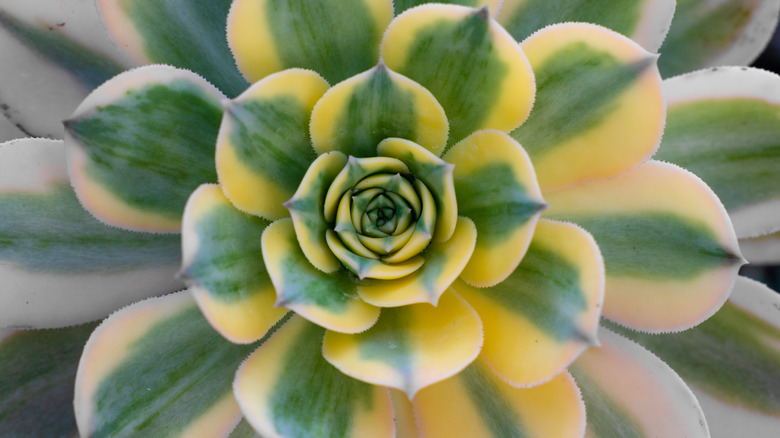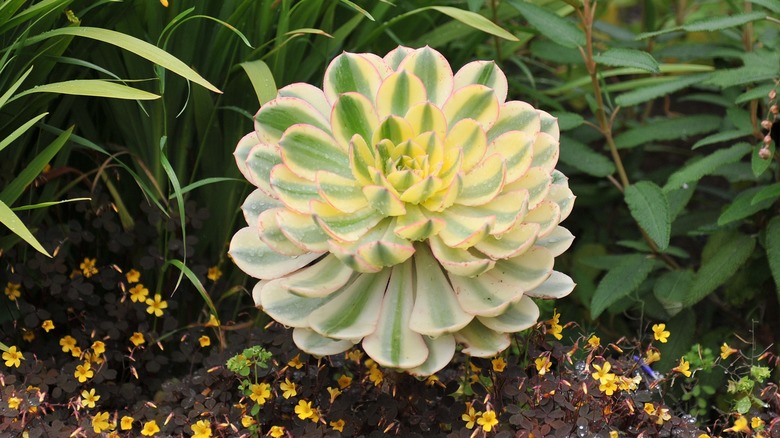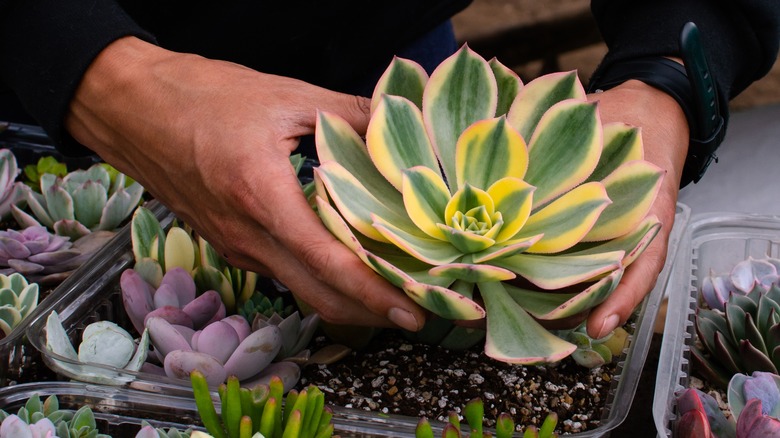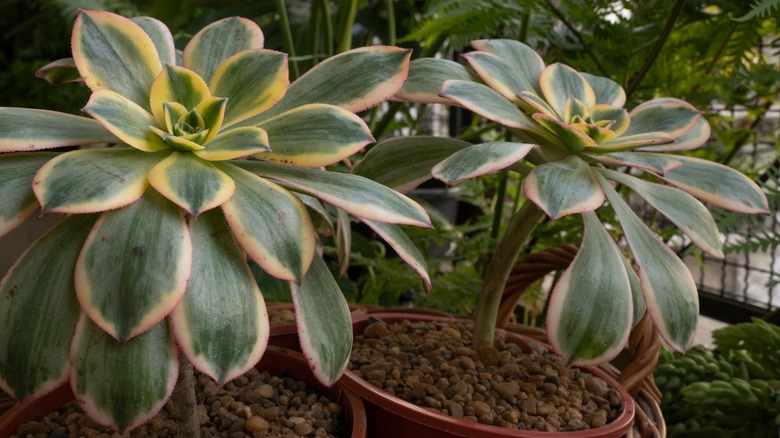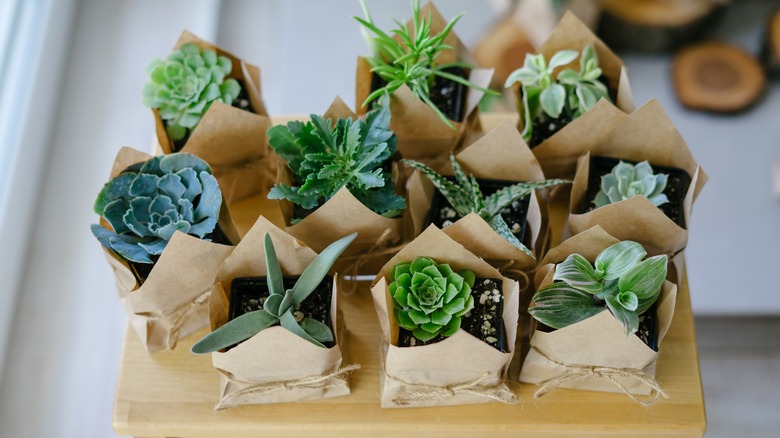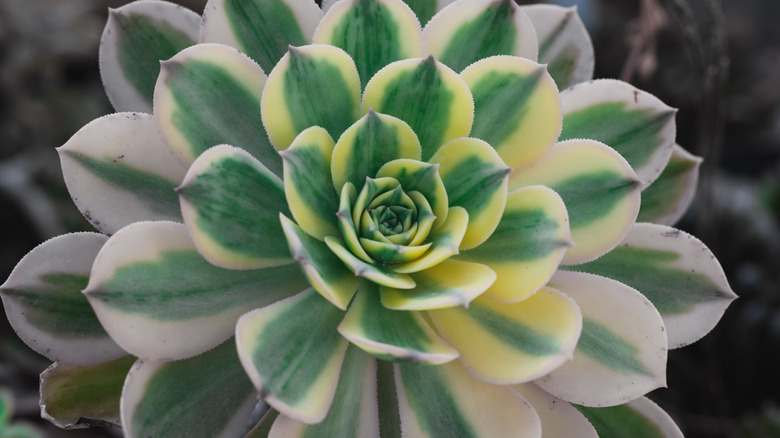How To Take Care Of Sunburst Succulents
Sunburst succulents, or aeonium sunburst plants, are a type of succulent that's relatively easy to care for, per Garden's Whisper. You may have heard this succulent called by other names, including copper pinwheel or tree aeonium. It ultimately gets its name because the rosette leaves look like rays of the sun. The rosettes of the succulent are quite large, and the copper-toned tips on them are beautiful.
This succulent can grow up to 18 to 24 inches tall and 24 inches wide, so it may be better to grow and cultivate them outdoors. The plant is native to the Canary Islands, so it is essential to ensure it's planted in a warm, sunny area. However, many sunburst succulents will die after blooming, but this occurrence can take a while, allowing you to enjoy your time with the plant. If you've been wanting to buy a succulent, take a look at the sections below to learn how to take care of one.
How To Use In Garden
If you're planning on growing your sunburst succulent outdoors, there are a few things to keep in mind. One of the biggest considerations to weigh are pests, such as aphids, spider mites, and mealybugs, per HGTV. These pests can consume your succulent and prevent it from growing healthy. For this reason, it's important to tend to your succulents and keep a close eye on them. It's recommended that you look out for signs of pests, including holes on the rosettes.
Another consideration is frost during the wintertime. While these types of plants thrive in warm, sunny environments, they become dormant during the winter. The Spruce suggested not watering your succulents during wetter and colder seasons since it can lead to rot. It may also be a good idea to move them indoors for the time being or place them somewhere they won't get wet if there's a lot of rainfall.
How To Grow Sunburst Succulents
According to the Spruce, aeonium plants require sandy loam, but you can also use a regular potting mix that has been amended with perlite to grow. Perlite is an additive that is often included in potting soil to allow water to seep more easily. Ensuring that your soil allows the succulent's roots to soak the water without becoming oversaturated is vital. While there are pre-made mixes that are designed for succulents, the soil recommended by the Spruce will work better since these types of succulents require a lot of moisture to survive. Tools you may need include gloves, pruning shears, and a watering can.
If you want more of these succulents in your garden, it's a good idea to propagate them. This means you'll cut off a leaf of the succulent to grow a whole new plant. To propagate sunburst succulents, remove a rosette leaf and place it in a warm spot with no sunlight. When the plant has healed from the cut you made, you can place it standing up (with the cut facing downward) in a pot with soil. Then, you can place it in a location where it'll receive indirect sunlight and watch it grow.
How To Care For Sunburst Succulents
Succulent plants are great for landscaping and can also be grown indoors. The best part is that sunburst succulents are easy plants to take care of when you have the right information under your belt. While pro gardeners may know exactly what they need, those with cursed black thumbs may struggle a bit. However, anyone can keep one alive by making sure it receives an adequate amount of water and sunlight. According to Garden's Whisper, sunburst plants need moderate sunlight–a minimum of six hours per day of direct sun is needed.
As for water, the succulent can survive off of moderate amounts. So, don't worry if you forget to water for a day or two. When you water sunburst succulents, make sure the soil is drenched. You won't have to re-water until the first 2 inches are dry to the touch. You can always press your knuckle into the soil to know whether the soil is dry or not.
Sunburst Succulent Varieties
While the sunburst succulent doesn't have other varieties, the plant is part of the Aeonium genus. According to MasterClass, there are other types of aeonium plants, including:
-
Noble Aeonium–Aeonium nobile is a succulent that can grow up 2 inches tall and 15 inches wide.
-
Tree houseleek–Aeonium arboreum has rosettes that can be 3 feet in length when planted in pots and 6 feet tall when grown outdoors.
-
Purple rose–Aeonium arboreum, or atropurpureum, is an aeonium plant with purple roses that can grow up to 3 feet in length and can withstand dryer climates.
-
Black rose–The black rose succulent, or aeonium arboreum Zwartkop is a plant that can grow leaves up to 8 inches and in different hues of black and purple.
- Kiwi aeonium–A kiwi aeonium plant, or aeonium haworthii Dream Color, is a plant that can grow up to 3 feet in length and 3 feet wide, and it often thrives in the summertime.
How To Repot Sunburst Succulents
If it's time to repot your succulent, it's important that you know how to transplant it properly. Otherwise, you may damage the plant and cause it to die as a result. The Spruce recommends repotting these types of plants every two to three years with new potting soil. So, you may want to hold off transplanting your plant until then. When it's time, follow the steps below:
Gather your materials, including gardening gloves, a new pot, potting soil, and a small shovel. Gently remove the succulent from the old pot by holding the pot sideways. Remove the soil from the stems and clean them with water. Let the roots dry in a place with no sunlight for three to five days. When the roots of the succulent are dry, fill the pot with soil and then plant it inside. Finish covering the plant with more soil and water. Make sure the pot has drainage holes to prevent rot.
